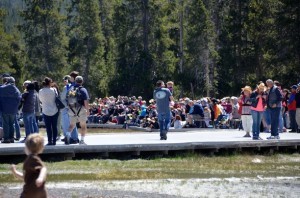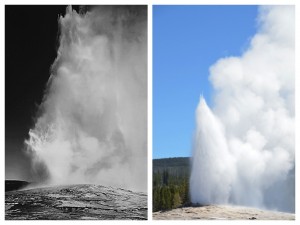Yellowstone’s Old Faithful Geyser: Tips and FAQs
I’m quite certain that the first time I was exposed to Yellowstone National Park’s Old Faithful Geyser was on my 60s-era Viewmaster when I was a child.
Little did I know that it would take me nearly 50 years to see it live, in person.
I find it quite remarkable that Ansel Adams snapped a photograph of Old Faithful in the late-1930s, and my 2013 photograph shows the veritable icon still puffing her steam a hundred feet in the air.
Note: click the photograph (right) for a much larger view.
Yellowstone National Park has nearly 60% of the world’s geysers, and the Upper Geyser Basin, home to Old Faithful, is home to the largest number of geysers in the park.
Old Faithful is a cone geyser, and was named in 1870 during the Washburn-Langford-Doane Expedition. Old Faithful received its moniker as it erupts nearly every 90 minutes, making it the most predictable geographic feature on earth.
Note: if you can’t see the video, click here.
Frequently Asked Questions About Old Faithful
Q. When does Old Faithful erupt?
A. Basic prediction of Old Faithful is dependent upon the duration of the previous eruption. During visitor center hours, geyser statistics and predictions are maintained by the naturalist staff. People speak of the average time between eruptions. This is misleading. Intervals can range from 60-110 minutes. Visitors can check for posted prediction times in most buildings in the Old Faithful area.
Q. How high does Old Faithful erupt and how long will it last?
A. Old Faithful can vary in height from 106-184 feet (32–56 m) with an average near 130 feet (40 m). This has been the historical range of its recorded height. Eruptions normally last between 1.5 to 5 minutes.
Q. I heard Old Faithful isn’t as faithful as it used to be. Is it slowing down?
A. It depends on what you call faithful. The famous geyser currently erupts around 17 times a day and can be predicted with a 90 percent confidence rate within a 10 minute variation. Because of changes in circulation that resulted from the 1959 Hebgen Lake and 1983 Borah Peak earthquakes, as well as other local and smaller earthquakes, the average interval between eruptions has been lengthening during the last several decades. In the past, Old Faithful displayed two eruptive modes: short duration eruptions followed by a short interval, and a long duration eruption followed by a long interval. However, after a local earthquake in 1998, Old Faithful’s eruptions are more often of the long duration, long interval type. If an eruption lasts less than 2.5 minutes then there will be a 60 minute interval. If an eruption lasts more than 2.5 minutes, there will be a 90 minute interval.
Q. How many gallons of water are expelled during an eruption?
A. It depends on the duration of the eruption. Scientists estimate that the amount ranges from 3,700 gallons (for a short duration of 1.5 minutes) to 8,400 gallons (for a longer duration of 4.5 minutes).
Q. How hot is the water in Old Faithful?
A. During an eruption, the water temperature at the vent has been measured at 204°F (95.6°C). The steam temperature has been measured above 350°F!
Note: FAQs from Yellowstone National Park website.
Tips for Viewing Old Faithful Geyser
 Yellowstone National Park gets over 3 million visitors each year, and Old Faithful is one of the most visited sites in the park. If you can, visit Yellowstone in late-March/early-June, and get to the geyser first thing in the morning. Otherwise, you’ll be standing with mobs of people from all over the world. We visited on June 8th, and the crowds weren’t too bad.
Yellowstone National Park gets over 3 million visitors each year, and Old Faithful is one of the most visited sites in the park. If you can, visit Yellowstone in late-March/early-June, and get to the geyser first thing in the morning. Otherwise, you’ll be standing with mobs of people from all over the world. We visited on June 8th, and the crowds weren’t too bad.- Bring a hat and water.
- There is a stadium area set up with benches to wait for Old Faithful to erupt. However, we preferred to keep away from the crowds for our photographs and video.
- If you plan to eat a meal after the eruption, consider heading back to the Old Faithful Inn before Old Faithful quits. Otherwise, plan to stand in a line with hundreds of new friends.
- We didn’t have time to take our own advice, but do consider walking around the plentiful other geysers that are within easy walking distance of Old Faithful.
When visiting Yellowstone’s Old Faithful Geyser, it’s a little intimidating to realize that you’re actually walking atop the caldera of one of the world’s largest volcanoes. This is made even more prominent to your senses when you actually witness all of the geological features being caused by boiling magma from deep inside the earth.
YIKES!
Nonetheless, the Old Faithful Geyser is worth a visit, and we hope that our helpful tips will make your visit a better experience. Have fun!
Link: Where to Stay in Yellowstone National Park
If you enjoyed this article, sign up for our monthly newsletter to keep abreast of our best travel tips, on-location reviews, exclusive travel offers, group travel events, and much more.

 The Roaming Boomers
The Roaming Boomers





What would happen if you stood in Old Faithful while it erupted, what would happen?
Hi Abbie,
The result would likely be death. We don’t recommend it.